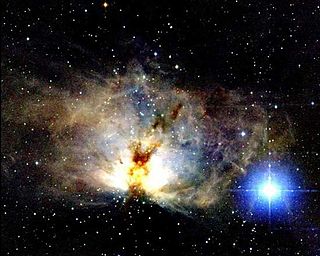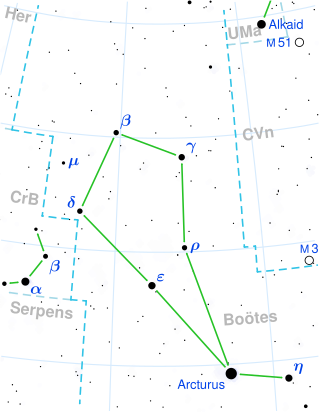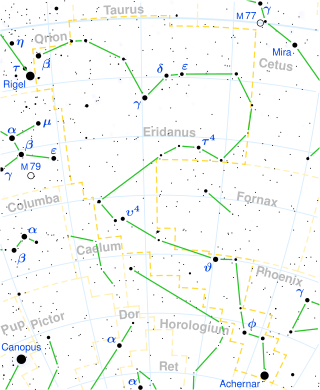
Alpha Herculis, also designated Rasalgethi and 64 Herculis, is a multiple star system in the constellation of Hercules. Appearing as a single point of light to the naked eye, it is resolvable into a number of components through a telescope. It has a combined apparent magnitude of 3.08, although the brightest component is variable in brightness. Based on parallax measurements obtained during the Hipparcos mission, it is approximately 360 light-years (110 parsecs) distant from the Sun. It is also close to another bright star Rasalhague in the vicinity.

Castor is the second-brightest object in the zodiac constellation of Gemini. It has the Bayer designation α Geminorum, which is Latinised to Alpha Geminorum and abbreviated Alpha Gem or α Gem. With an apparent visual magnitude of 1.58, it is one of the brightest stars in the night sky. Castor appears singular to the naked eye, but it is actually a sextuple star system organized into three binary pairs. Although it is the 'α' (alpha) member of the constellation, it is half a magnitude fainter than 'β' (beta) Geminorum, Pollux.

Alnilam is the central star of Orion's Belt in the equatorial constellation of Orion. It has the Bayer designation ε Orionis, which is Latinised to Epsilon Orionis and abbreviated Epsilon Ori or ε Ori. This is a massive, blue supergiant star some 1,200 light-years distant. It is estimated to be 419,600 times as luminous as the Sun, and 40 times as massive.

Bellatrix is the third-brightest star in the constellation of Orion, positioned 5° west of the red supergiant Betelgeuse. It has the Bayer designation γ Orionis, which is Latinized to Gamma Orionis. With a slightly variable magnitude of around 1.6, it is typically the 25th-brightest star in the night sky. Located at a distance of 250±10 light-years from the Sun, it is a blue giant star around 7.7 times as massive as the sun with 5.75 times its diameter.

Delta Arietis, officially named Botein, is a star in the northern constellation of Aries, 1.8 degrees north of the ecliptic. The apparent visual magnitude is 4.35, so it is visible to the naked eye. It has an annual parallax shift of 19.22 mas; corresponding to a distance of about 170 ly (52 pc) from the Sun.

Alnitak is a triple star system in the constellation of Orion. It has the designations ζ Orionis, which is Latinised to Zeta Orionis and abbreviated Zeta Ori or ζ Ori, and 50 Orionis, abbreviated 50 Ori. The system is located at a distance of several hundred parsecs from the Sun and is one of the three main stars of Orion's Belt along with Alnilam and Mintaka.

Meissa, designated Lambda Orionis is a star in the constellation of Orion. It is a multiple star approximately 1,300 ly away with a combined apparent magnitude of 3.33. The main components are an O8 giant star and a B-class main sequence star, separated by about 4″. Despite Meissa being more luminous and only slightly further away than Rigel, it appears 3 magnitudes dimmer at visual wavelengths, with much of its radiation emitted in the ultraviolet due to its high temperature.

Alphard, designated Alpha Hydrae, is the brightest star in the constellation of Hydra. It is a single giant star, cooler than the Sun but larger and more luminous. It is about 177 light-years away.

Sigma Sagittarii, Latinized from σ Sagittarii; formally named Nunki, is the second-brightest star in the constellation of Sagittarius. It has an apparent magnitude of +2.05, making it readily visible to the naked eye. The distance to this star, determined using parallax measurements from the Hipparcos astrometry satellite, yields a value of approximately 228 light-years from the Sun.

Epsilon Boötis, officially named Izar, is a binary star in the northern constellation of Boötes. The star system can be viewed with the unaided eye at night, but resolving the pair with a small telescope is challenging; an aperture of 76 mm (3.0 in) or greater is required.

Pi Sagittarii is a triple star system in the zodiac constellation of Sagittarius. It has an apparent visual magnitude of +2.89, bright enough to be readily seen with the naked eye. Based upon parallax measurements, it is roughly 510 light-years from the Sun.

Theta Eridani, Latinized from θ Eridani, is a binary system in the constellation of Eridanus with a combined apparent magnitude of 2.88. Its two components are designated θ1 Eridani, formally named Acamar, and θ2 Eridani. The system's distance from the Sun based on parallax measurements is approximately 165 light-years.

Beta Aquarii is a single yellow supergiant star in the constellation of Aquarius. It has the official name Sadalsuud and the Bayer designation β Aquarii, abbreviated Beta Aqr or β Aqr. Based upon parallax measurements obtained during the Hipparcos mission, this component is located at a distance of approximately 540 light years (165 parsecs) from the Sun. It is drifting further away with a radial velocity of 6.5 km/s. The star serves as an IAU radial velocity standard.

Epsilon Aquarii, Latinized from ε Aquarii, is a binary star in the equatorial zodiac constellation of Aquarius, located near the western constellation border with Capricornus. It has the proper name Albali, now formally recognized by the IAU. It is visible to the naked eye with an apparent visual magnitude of 3.77, and has an absolute magnitude of −0.46. Based upon parallax measurements taken by the Gaia spacecraft, it is located at a distance of approximately 244 light-years (75 pc) from Earth. The star is drifting closer with a radial velocity of −20 km/s.

Alpha Crateris, officially named Alkes, is a star in the constellation of Crater. It is a cool giant star about 43.2 parsecs (141 ly) away.

Pi4 Orionis (π4 Ori, π4 Orionis) is a binary star system in the western part of the Orion constellation. It is visible to the naked eye with an apparent visual magnitude of 3.7. Based upon an annual parallax shift of 3.1 mass, it is located roughly 1,050 light-years from the Sun.

Beta Aquilae, Latinized from β Aquilae, is a triple star system in the equatorial constellation of Aquila. It is visible to the naked eye as a point-like source with an apparent visual magnitude of 3.87. Based on parallax measurements obtained during the Hipparcos mission, it is located at a distance of approximately 44.7 light-years from the Sun. It is drifting closer to the Sun with a radial velocity of −40 km/s.

Omicron2 Canis Majoris is a star in the constellation Canis Major. Since 1943, the spectrum of this star has served as one of the stable anchor points by which other stars are classified. It has an apparent visual magnitude of 3.043, making it one of the brighter members of the constellation. Based upon a distance modulus of 10.2, it is about 3,600 light-years from Earth.

Epsilon Delphini, officially named Aldulfin, is a solitary, blue-white hued star in the northern constellation of Delphinus. It is visible to the naked eye with an apparent visual magnitude of 4.03. Based upon an annual parallax shift of 9.87 mas as seen from the Earth, the system is located about 330 light-years from the Sun. At Epsilon Delphini's distance, the visual magnitude is diminished by an extinction factor of 0.11 due to interstellar dust. The star is moving closer to the Sun with a radial velocity of −19 km/s.

Nu Orionis is a binary star system in the northeastern part of the constellation Orion. It should not be confused with the variable star NU Orionis. Nu Orionis has an apparent visual magnitude of 4.42, which is bright enough to be seen with the naked eye. Based upon an annual parallax shift of 0.00632 arcseconds, the distance to this system is roughly 520 light years.
















